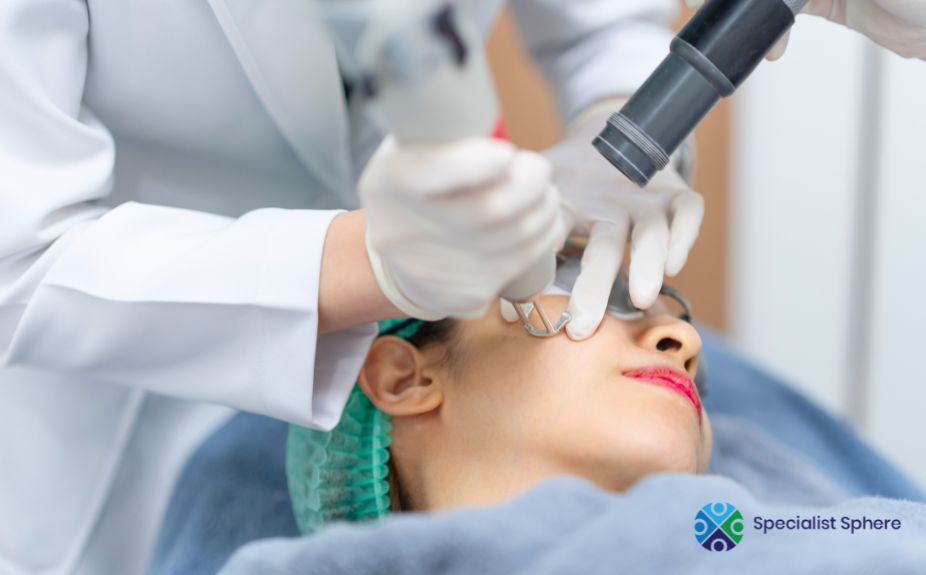Pico Laser technology represents a significant advancement in cosmetic dermatology, offering a safe and effective solution for a wide range of skin concerns. Unlike traditional lasers that use heat, Pico Laser utilizes ultra-short energy bursts to target pigmentation, stimulate collagen, and improve skin texture with minimal damage to the surrounding tissue. This guide explores the safety profile of Pico Laser, detailing its benefits, potential side effects, and what you can expect throughout your treatment journey
What is Pico Laser and How Does it Work?
Pico Laser is a non-ablative laser that delivers energy in picoseconds—one trillionth of a second. This incredibly fast delivery creates a unique photoacoustic effect, shattering pigment and stimulating the skin’s natural healing processes without relying on high heat.
How does this technology benefit your skin?
- Pigment Fragmentation: The laser shatters unwanted melanin or tattoo ink into tiny particles. The body’s lymphatic system then naturally flushes these particles away, leading to a clearer complexion or faded tattoos.
- Collagen Stimulation: The rapid pressure waves created by the laser trigger a natural healing response, encouraging the production of new collagen and elastin. This process helps to improve skin texture, reduce the appearance of fine lines, and minimize pores.
- Minimal Thermal Damage: By operating at such a high speed, Pico Laser generates very little heat. This significantly reduces the risk of burns and post-inflammatory hyperpigmentation, making it a safer option for a broader range of skin types.
Common Pico Laser Applications: What Can It Treat?
Pico Laser technology is versatile and can be customized to treat various skin issues on different body areas.
- Pigmentation: Effectively targets age spots, sun damage, freckles, and certain types of melasma.
- Acne Scarring: Collagen stimulation helps to improve the texture and appearance of both atrophic and hypertrophic acne scars.
- Tattoo Removal: Highly effective for removing multi-colored and stubborn tattoos, including those that have been unresponsive to traditional laser treatments.
- Skin Rejuvenation: Improves overall skin tone, minimizes enlarged pores, and softens fine lines for a smoother, more radiant complexion.
Is Pico Laser Safe for All Skin Tones?
Yes, Pico Laser is widely regarded as one of the safest laser treatments available, particularly for individuals with darker skin tones (Fitzpatrick IV–VI). The key to its safety lies in the minimal thermal energy it produces.
Why is Pico Laser safer than traditional lasers?
- Reduced Risk of Hyperpigmentation: Less heat exposure means a lower chance of triggering the overproduction of melanin, which is a common risk with traditional lasers on darker skin.
- Lower Chance of Scarring: The absence of significant thermal injury minimizes the risk of textural changes or scarring.
- Faster Recovery Time: Most patients experience only mild, temporary side effects like redness and swelling, which typically subside within 24-48 hours.
What to Expect: Before, During, and After Your Pico Laser Treatment
Q: How do I prepare for a Pico Laser session?
A: During your initial consultation, a qualified practitioner will assess your skin and medical history. You may be advised to avoid direct sun exposure, tanning, and certain skincare products in the weeks leading up to your appointment.
Q: What does a Pico Laser treatment feel like?
A: Most patients describe the sensation as a series of quick, light snaps against the skin. A topical numbing cream can be applied to enhance comfort, though it is often not necessary.
Q: What are the side effects of Pico Laser treatment?
A: Side effects are typically mild and temporary. You may experience:
- Mild redness and swelling: Similar to a light sunburn, this usually resolves within 1-2 days.
- Temporary darkening of treated spots: Pigmented areas may appear darker before flaking off naturally over 1-2 weeks.
- Light flaking or dryness: This is a normal part of the healing process, especially in areas with dense pigmentation.
Who is a good candidate for Pico Laser treatment?
While Pico Laser is safe for most individuals, a comprehensive consultation is essential to determine suitability. You may not be an ideal candidate if you have:
- Active skin infections or open wounds in the treatment area.
- Recent sunburn or an active tan.
- Pregnancy or are breastfeeding.
- A history of keloid scarring.
- Taken medications that increase light sensitivity.
Choosing a Reputable Pico Laser Clinic in Singapore
The safety and effectiveness of your Pico Laser treatment depend heavily on the expertise of your provider. When seeking a Pico laser specialist in Singapore, consider the following factors:
- Clinic Credentials: Look for clinics that are Ministry of Health (MOH) registered with licensed medical practitioners.
- Experience: Choose a clinic with a proven track record of treating a wide range of skin types, including darker and sensitive skin.
- Authentic Technology: Ensure the clinic uses genuine, properly maintained Pico Laser devices.
- Comprehensive Consultation: A thorough consultation should include a detailed medical history review and a personalized skin assessment to tailor the treatment to your specific needs.
By selecting a trusted and experienced professional, you can ensure your treatment is both safe and effective, delivering the best possible results.
Pico Laser offers a safe, effective, and minimally invasive solution for a variety of skin concerns. Its advanced technology provides excellent results with a low risk of side effects and minimal downtime. If you’re ready to achieve a clearer, more youthful complexion, consult with a qualified professional to explore the benefits of Pico laser treatment in Singapore.


